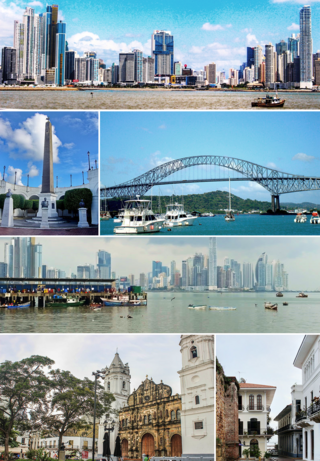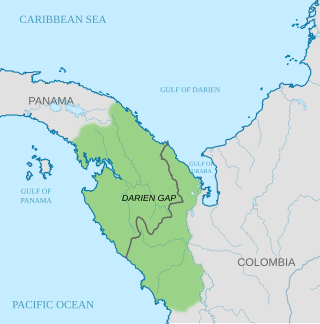
Central America is a subregion of the Americas. Its boundaries are defined as bordering Mexico to the north, Colombia to the south, the Caribbean Sea to the east, and the Pacific Ocean to the west. Central America usually consists of seven countries: Belize, Costa Rica, El Salvador, Guatemala, Honduras, Nicaragua, and Panama. Within Central America is the Mesoamerican biodiversity hotspot, which extends from northern Guatemala to central Panama. Due to the presence of several active geologic faults and the Central America Volcanic Arc, there is a high amount of seismic activity in the region, such as volcanic eruptions and earthquakes which has resulted in death, injury, and property damage.

Panama, officially the Republic of Panama, is a transcontinental country spanning the southern part of North America and the northern part of South America. It is bordered by Costa Rica to the west, Colombia to the southeast, the Caribbean Sea to the north, and the Pacific Ocean to the south. Its capital and largest city is Panama City, whose metropolitan area is home to nearly half the country's 4 million people.

The history of Panama includes the history of the Isthmus of Panama prior to European colonization.

The economy of Panama is based mainly on the services sector, which accounts for nearly 80% of its GDP and accounts for most of its foreign income. Services include banking, commerce, insurance, container ports, and flagship registry, medical and health and tourism. The Panama Canal and the nearby Colón Free Trade Zone make an important economic contribution. The country's industry includes manufacturing of aircraft spare parts, cement, drinks, adhesives and textiles. Additionally, exports from Panama include bananas, shrimp, sugar, coffee, and clothing. Panama's economy is fully dollarized, with the US dollar being legal tender in the country. Panama was the first foreign country to adopt the U.S. dollar as its legal currency (1903) after its secession from Colombia temporarily deprived it of a local currency. Panama is a high income economy with a history of low inflation.

The Panama Canal is an artificial 82 km (51 mi) waterway in Panama that connects the Atlantic Ocean with the Pacific Ocean and divides North and South America. The canal cuts across the Isthmus of Panama and is a conduit for maritime trade. One of the largest and most difficult engineering projects ever undertaken, the Panama Canal shortcut greatly reduces the time for ships to travel between the Atlantic and Pacific oceans, enabling them to avoid the lengthy, hazardous Cape Horn route around the southernmost tip of South America via the Drake Passage or Strait of Magellan.

Panama City, also known as Panama, is the capital and largest city of Panama. It has a total population of 1,938,000, with over 1,500,189 in its urban area. The city is located at the Pacific entrance of the Panama Canal, in the province of Panama. The city is the political and administrative center of the country, as well as a hub for banking and commerce.

Manuel Antonio Noriega Moreno was a Panamanian dictator, politician and military officer who was the de facto ruler of Panama from 1983 to 1989. An authoritarian ruler who amassed a personal fortune through drug trafficking operations, he had longstanding ties to United States intelligence agencies before the U.S. invasion of Panama removed him from power.

Panama City is a city in and the county seat of Bay County, Florida, United States. Located along U.S. Highway 98 (US 98), it is the largest city between Tallahassee and Pensacola. It is also the most populated city of the Panama City–Lynn Haven, Florida metropolitan statistical area. Panama City was severely damaged when Hurricane Michael made landfall as a Category 5 hurricane on October 10, 2018. As of the 2020 census, the population was 35,392, down from the figure of 36,484 at the 2010 census.

Panama City Beach is a resort town in Bay County, Florida, United States, on the Gulf of Mexico coast. As of the 2010 census it had a population of 12,018. The city is often referred to under the umbrella term of "Panama City". Panama City Beach's slogan is "The World's Most Beautiful Beaches" due to the unique, sugar-white sandy beaches of northwest Florida.

The United States invasion of Panama, codenamed Operation Just Cause, lasted over a month between mid-December 1989 and late January 1990, ten years after the Torrijos–Carter Treaties which was ratified to transfer control of the Panama Canal from the United States to Panama by January 1, 2000. The invasion took place during the presidency of George H. W. Bush.

The Panama Canal Zone, also simply known as the Canal Zone, was an unincorporated territory of the United States, located in the Isthmus of Panama, that existed from 1903 to 1979. It was located within the territory of Panama, consisting of the Panama Canal and an area generally extending five miles (8 km) on each side of the centerline, but excluding Panama City and Colón. Its capital was Balboa.

The Darién Gap is a geographic region in the Isthmus of Darien or Isthmus of Panama connecting the North and South American continents within Central America, consisting of a large watershed, forest, and mountains in Panama's Darién Province and the northern portion of Colombia's Chocó Department.

A Panama hat, also known as an Ecuadorian hat, a jipijapa hat, or a toquilla straw hat, is a traditional brimmed straw hat of Ecuadorian origin. Traditionally, hats were made from the plaited leaves of the Carludovica palmata plant, known locally as the toquilla palm or jipijapa palm, although it is a palm-like plant rather than a true palm.

The Panama–Pacific International Exposition was a world's fair held in San Francisco, California, United States, from February 20 to December 4, 1915. Its stated purpose was to celebrate the completion of the Panama Canal, but it was widely seen in the city as an opportunity to showcase its recovery from the 1906 earthquake. The fair was constructed on a 636 acre(1 sq. mi., 2.6 km2) site along the northern shore, between the Presidio and Fort Mason, now known as the Marina District.

The Torrijos–Carter Treaties are two treaties signed by the United States and Panama in Washington, D.C. on September 7, 1977, which superseded the Hay–Bunau-Varilla Treaty of 1903. The treaties guaranteed that Panama would gain control of the Panama Canal after 1999, ending the control of the canal that the U.S. had exercised since 1903. The treaties are named after the two signatories, U.S. president Jimmy Carter and the Commander of Panama's National Guard, General Omar Torrijos.

The Panama national football team represents Panama in men's international football and is governed by the Panamanian Football Federation. The team represents all three FIFA, CONCACAF and the regional UNCAF.

The Panamanian Football Federation, known as FEPAFUT, is the official governing body of football in Panama and is in charge of the Panama national football team. FEPAFUT was a founding member of CONCACAF in 1961.
The Señorita Panamá is a national beauty pageant in Panama. As of the 2021 edition, its winners represent Panama in Miss International and Miss Supranational. The Miss Panama brand started in 1952, when the Panamanian Institute of Tourism received an invitation from Miss Universe to send a representative. In 1975, the Señorita Panamá name was used for the first time, reverting to Miss Panama in 1976. In 1982, Señorita Panamá was created by RPC Channel 4 as an alternative to send its winners to the Miss World contest in London. These pageants, along with smaller pageants such as Miss International Panamá and Miss World Panamá celebrated to select delegates for international representations.

The Panama Papers are 11.5 million leaked documents that were published beginning on April 3, 2016. The papers detail financial and attorney–client information for more than 214,488 offshore entities. The documents, some dating back to the 1970s, were created by, and taken from, former Panamanian offshore law firm and corporate service provider Mossack Fonseca, and compiled with similar leaks into a searchable database.

The COVID-19 pandemic in Panama is part of the worldwide pandemic of the coronavirus disease caused by severe acute respiratory syndrome coronavirus 2. The virus was confirmed to have spread to Panama on 9 March 2020. One of the dead was a 64-year-old male, who also had diabetes and pneumonia. Of those infected, 83 were hospitalized. The infected individuals belonged to the 29-59 age group and had each recently travelled abroad. A 13-year-old girl died of COVID-19 on 23 March 2020.


















